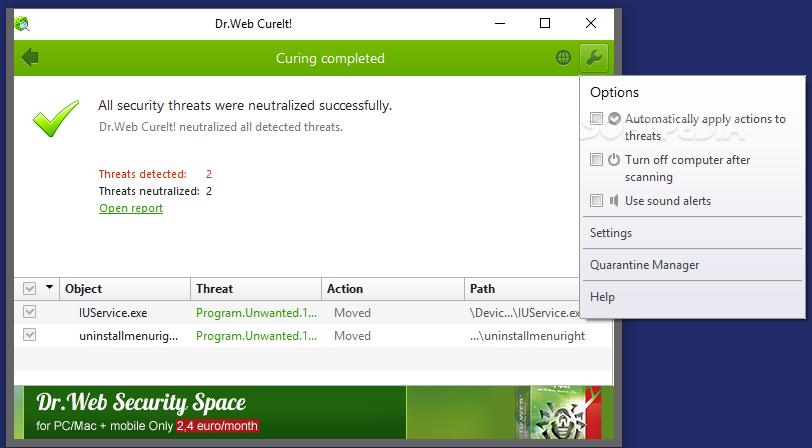Dr.Web was one of the world’s first anti-viruses
However, Dr.Web would likely never have been created if the first viruses had not appeared; and they, in turn, would never have appeared were it not for the fact that a habitat exists for them—i.e., computers and computer networks.
On the occasion of the Dr.Web anti-virus’s birthday, which is celebrated in April, we invite you to take a brief history tour and to remember the virus and anti-virus pioneers who left an indelible mark on the rapid and eventful computerisation of our society. They were the vanguard; they came from very different walks of life, had very different intentions, and were often far ahead of their time!

Doctor Webは、Dr.Web Mobile Control Center for iOSをバージョン13.0.0へアップデートしました。今回のアップデートでは、Dr.Web AV-Desk 13.0のサポート、改善が. Dr.Web—the Russian anti-virus. The Russian developer of Dr.Web anti-virus software, Doctor Web is one of few anti-virus vendors to have its own malware detection and curing technologies. The Dr.Web anti-virus, whose origins date back to 1992, is one of the world’s first anti-viruses. Dr.Web — innovative anti-virus technologies. Comprehensive protection from Internet threats. Dr.Web was one of the world’s first anti-viruses. However, Dr.Web would likely never have been created if the first viruses had not appeared; and they, in turn, would never have appeared were it not for the fact that a habitat exists for them—i.e., computers and computer networks. On the occasion of the Dr.Web anti-virus’s birthday, which.
The ideas were in the air…

Dr. Webb Gastroenterologist
The idea of a self-replicating system was first put forward by the ”father of the computer” John von Neumann. The materials that von Neumann used in his lectures on this topic were later incorporated into his book, Theory of Self-Reproducing Automata, over sixty years ago, in 1951.
A computer virus
The emergence of the term 'computer virus' was inevitable. It’s difficult to say who used it first. Some believe that it was coined by Gregory Benford in his short story, The Scarred Man, which was published in 1970. In the story, the word virus is used in relation to a computer program. It is noteworthy that the story also mentions a program for neutralising viruses—a “vaccine”!
The first viruses
Created in 1961, the game Darwin enabled players to load programs into a computer’s memory, so that the species designed by one player had to destroy the other species and claim its habitat.
In 1971 “The Creeper”, the first program that can be considered a virus in the modern sense of the word, appeared. It didn’t inflict any damage; it only displayed the message:I`M THE CREEPER: CATCH ME IF YOU CAN
But it could spread across a network and, therefore, became the first network worm in history.
It also facilitated the birth of the first anti-virus, the program “Reaper”, which essentially was another worm. “Reaper” would spread over networks, never manifesting its presence on infected machines. If it managed to find “The Creeper” on a machine, it would delete it.
Viruses are spreading
Things are getting serious
The first known real viruses were “Virus 1, 2, 3” and “Elk Cloner” for Apple II—yes, that’s right, the future Mac for which viruses supposedly don’t exist. Both viruses emerged in 1981.
The first virus outbreak
By the mid-80s, the wide popularity of IBM PCs resulted in virus outbreaks.
The first computer virus epidemic in 1987 involved a quite harmless virus called “Brain”. During the year in which it existed, it managed to infect many computers around the world, although it was originally developed to track and stop the distribution of illegal copies of heart monitoring software.
Research begins
In 1980 Jürgen Kraus wrote his student thesis 'Selbstreproduktion bei Programmen' (“The self-reproduction of programs”) at the University of Dortmund. In addition to theoretical materials, the thesis listed self-replicating Siemens computer programs that really existed at that time. This was the first time that a research work postulated that computer programs can behave like biological viruses.
The first clear definition of a virus was provided in 1983 by Fred Cohen, who at that point was a student at the University of Southern California’s School of Engineering.
'We define a computer 'virus' as a program that can 'infect' other programs by modifying them to include a possibly evolved copy of itself. With the infection property, a virus can spread throughout a computer system or network using the authorizations of every user using it to infect their programs. Every program that gets infected may also act as a virus and thus the infection grows'.
Fred Cohen, Computer Viruses - Theory And Experiments
Shortly before Dr.Web
In 1988, the first version of the Aidstest anti-virus was developed in Russia by Dmitry N. Lozinsky. It was used virtually on every PC in the USSR and later in the CIS, and stayed ahead of its competitors for years. Lozinsky’s program helped many users, including businesses and governmental institutions, to cope with viruses at the dawn of their era. Currently, Dmitry Lozinsky serves as Deputy General Director at Doctor Web.
Dmitry Lozinsky was among those figures who defined the development of Russian programming and spearheaded the first Russian anti-virus software.
Nikolay N. Bezrukov was the man behind the first steps taken in virusology in the USSR (starting in 1989). One of his workshops devoted to system programming focused largely on computer viruses.
Mac os high sierra dmg free download. Later Bezrukov wrote the book Computer virusology which was published in 1991 and had a profound influence on Igor Danilov.
The first release of Spider’s Web
1992
The author of the Dr.Web anti-virus, Igor Danilov began his anti-virus experiments in 1990-1991. It was then that the first prototypes of the monitor and scanner were created.
In 1992, the first version of Spider’s Web, which incorporated the resident monitor Spider and the doctor Web (scanner) appeared.
It was doctor Web that subsequently (in 1994) gave the entire family of anti-virus programs created by Igor Danilov the name that became famous all over the world: Dr.Web.
'There was a time when I was all alone, and my workplace was in a basement. Now, we are a team in a comfortable office and there are branch offices in various countries around the world'.
Igor Danilov
The Spider vs. The 'Chameleons'
The first polymorphic virus “Chameleon” appeared in early 1990. Previously viruses were identified by a certain portion of their code (signature). Even those encrypted with a variable key could still be detected by the code used for their decryption. However, this technique could not be applied to polymorphic viruses. Several routines for modifying their code ensure that several samples of the same virus never share a similar portion of code.
When polymorphic viruses began spreading on a massive scale, Dr.Web became the first program in the history of the anti-virus industry that could detect and cure the most diverse polymorphic viruses including the most complex ones. This technological advantage is what first made Dr.Web famous among IT professionals.
Dr.Web: origins
1994


This is what the first Dr.Web interfaces looked like
Dr. Webber Md
Your personal assistant and guide to services
Download Wizard
Download Dr.Web programs, key files and license certificates directly from My Dr.Web Portal.
License Manager
Alliance of valiant arms download mac. All of your license details are stored in this section. At any time you can check a license's status and parameters and get the contact information of the company that supplied it.
Links to renew and expand licenses are located next to the serial numbers. Remember, it does not matter how much time has passed since your Dr.Web license expired, you can always renew it at a discount — starting at 40% off if you renew for 1 year.
Renewal Wizard
The handy Dr.Web license purchase, renewal and expansion assistants located right in My Dr.Web Portal, will help you choose the license you need.
Additional option:
- Renewal bonuses and discounts — from 40% for a 1-year license
- Expansion is free for up to 5 PCs! Or at a renewal discount
License expansion Wizard
If you already use Dr.Web and have a newly purchased desktop or laptop that requires Dr.Web protection, expand your license for up to 5 PCs, free of charge, provided that your license expires in 3 months or less. In other cases you can expand your license at the renewal discount. You can do this in My Dr.Web Portal.
Dr. Webb Obgyn
Support and self-support
The form for contacting customer support can be found in the Support tab. Here you will find the 24/7 support phone number (calls made within the territory of Russia are free!) and a link for contacting a virtual engineer who helps solve virus-infection problems remotely.
To go to the archive of your requests, click on History of requests.
Restore a blocked key
If your key is blocked due to piracy (alas, this is often the case), you can restore your license free, but only once. To do this, go to the Blocked licenses section and next to the blocked license, click on 'Replace serial number'. A new Dr.Web key file will be sent to the email address you provided when you registered your license.
- Read more about our blocked key file replacement service
- Rules for blocking pirated licenses
- How to keep your license safe from pirates
Certificates
Doctor Web pays great attention to educating users on the basics of computer literacy. Here you will find a list of available exams and a link to the exam registration page. If you pass the exam, you will be able to download your Dr.Web certificate in this section.
Information
A notification about registering your Dr.Web license will be the first message you see in this section. After that, Doctor Web reminders about the imminent expiry of your license and your renewal options will be arriving here. These messages are sent to the email address you provided when you registered your license. Messages associated with the license are stored in this section while the license is valid and for another 60 days after its expiry.
In addition, you can enable special free SMS notifications and receive messages on your mobile phone about your license's expiry or an illegal attempt to use your license.
How do I log in to My Dr.Web Portal?
- First, you need to start using Dr.Web and install the anti-virus on your PC, Mac or handheld.
- The My Dr.Web menu item is available in the application menu. To access the menu, right-click on the Dr.Web icon in the system tray.
- You can also log in using your serial number via this service.
And also
- Service SMS and email notifications (renewal reminders and notifications about illegal attempts to use your license, e.g., to get a renewal discount)
- License certificate generator — get documentary evidence that your license was acquired legally.
- Individual distribution generator for Dr.Web CureIt!
- Form for scanning suspicious files and sending them to the Dr.Web anti-virus lab.
- Malware description search form
- News feeds.
- Links to Doctor Web's pages on social media.
